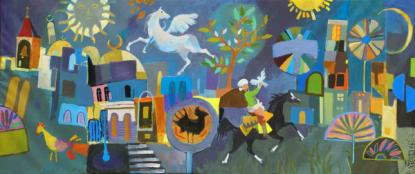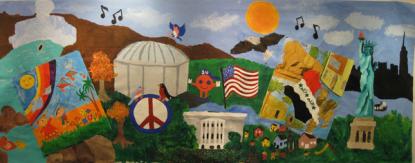
The Mural Project’s “How Will They Know Us?” project raises more questions than provides us with answers about American and Iraqi children living during quite tumultuous times. The children were given the explanation that people on the “other side” don’t know anything about them, except what they read or see in the media. The prompt that gave rise to the children’s artwork was the idea that, according to Claudia Lefko, founder of the Iraqi Children’s Art Exchange, they “had an opportunity to explain and describe themselves to people who not only knew very little about them, but thought of them as their ‘enemy.’”
Claudia asked me to consider the question of “the message in children’s art . . . are they really trying to express themselves, say something? How do we read it?” She also posed the question why certain images were included in the murals, such as in the mural by a group of 8-year-old African Americans from an impoverished neighborhood in Syracuse NY who drew flags and the Statue of Liberty. Whose ideas were these?
I began my thinking about the murals with the question of who was directing the children to create these images. Claudia informed me that the projects were implemented in a variety of ways, with no set format other than to ask the children to draw something about themselves and/or their communities. In some situations, some parents dictated what should be represented and what should be excluded. Some artists collaborated with the children to make sure they could be successful in illustrating the images that they would like to portray. Some mural projects had children working on them for several months, while others only a day or two. You can see that the children, therefore, may have not have had a strong role in determining the images that they formed, or had adequate time or skills to express their ideas fully.
We can never know if these murals are truly the “message” of the children or of the adults. In my past experience working in inner city schools in NYC with multiple handicapped children, I found that nine times out of ten, the adults were responsible for creating not only the ideas or content of the children’s art work, but also the actual art itself. Schools sent home to parents their children’s art projects, but it was obvious there was no way possible their children could have developed the ideas for the works or physically executed them. I went to these schools to encourage the teachers to allow the children to make any kind of mark they possible could, using manipulatives or helping the children hold the paintbrushes and markers. This action, this making a mark on the world is so significant and yet gets overlooked when the desire of adults is to have a “good finished product.”
I am not suggesting that the adults made the murals or did not have good intentions with this project. On the contrary, I think the quality of the murals suggests the success of the adults really working hard with the children to make beautiful images. I am left wondering, however, how much did the children feel the need to express images that would make the adults happy? Also perhaps like the NYC teachers, the adults who helped with the mural project wanted the art to represent the success of their children. While in the case of the NYC teachers they were creating an illusion of success for their community and for the parents, the mural project adults were anxious for the images to show the actual capabilities and compassion of their children on an international level.

On the one hand, the murals may be a reflection of adult intervention; on the other hand, they reflect children’s ability to respond to broad topics or topics that are complicated and difficult to express visually. In the Syracuse mural, for instance, there is a dove, yellow ribbon and peace symbol, obviously representing peace. When I curated a show for Kidspace at MASS MoCA, North Adams, MA, on children’s artwork from around the world, we asked children to create drawings with messages of peace that Claudia sent to Iraqi children living in Jordan. Interestingly, many of these images included the typical symbols as mentioned above, with an occasional anti-Bush drawing thrown into the mix.
I concluded that for the most part, when given such a broad topic or an issue that is difficult to express, children, particularly those who are of early elementary age or who have had little art exposure, will illustrate what comes easy or that is part of their shared symbol system. They will make reference to images /icons /symbols they have seen in other contexts such as in coloring books, magazines, cartoons and other forms of popular culture. This referencing of shared symbols is perhaps more so evident in the work by American children, and it would be an interesting discussion to examine why this phenomenon is not evident in the Iraqi children’s work.
When asked by the editor of the “The Public Humanist” for my observations of the effects of world violence (and/or media violence) in children’s art, I definitely had to hesitate because this is such a huge topic. I am certain there is an effect of the media, popular culture, and violence on children’s symbol systems. For instance, one drawing on view in the Kidspace children’s art exhibition was made by an Iraqi child portraying a Barbie doll-like figure with long blonde hair. Apparently, American soldiers had given her this doll and now she had embraced this American ideal of beauty in her own art work, though there are not many Iraqi women with long blonde hair for her to reference in her own culture.
But contemplating the effects of world violence on children’s art requires a lot more thinking (perhaps a dissertation!). Nevertheless, what I have been suggesting in this piece is that adults play a strong role in determining the degree of impact that the violent times in which children are currently being raised will have on children’s symbol systems and artistic practice. In some cases, children may be sheltered from the violence or in others, be directed by adults as to how they should express their thoughts and concerns instead of being allowed / encouraged to make their own artistic marks. Also, we have to give consideration to the fact that children have a difficult time with processing complex social topics like war, so it is no wonder that it might be problematical to represent these issues visually.


